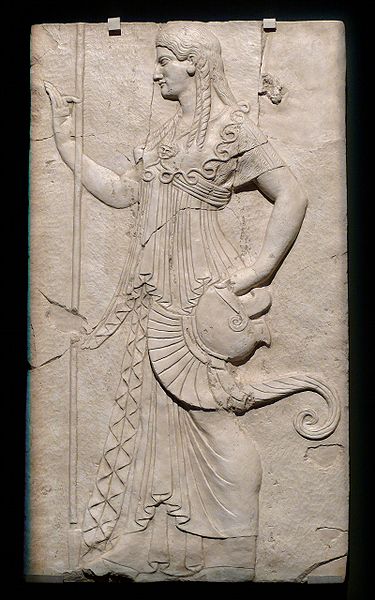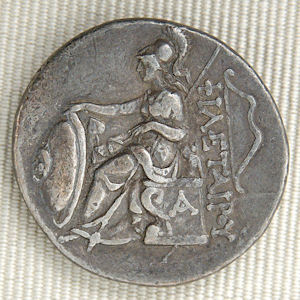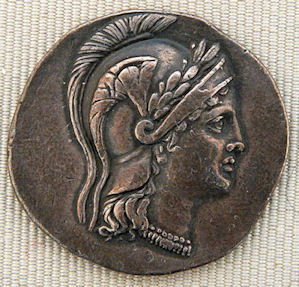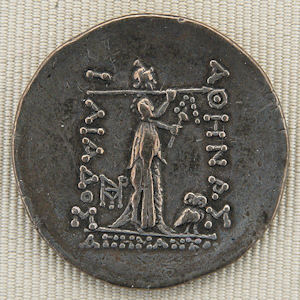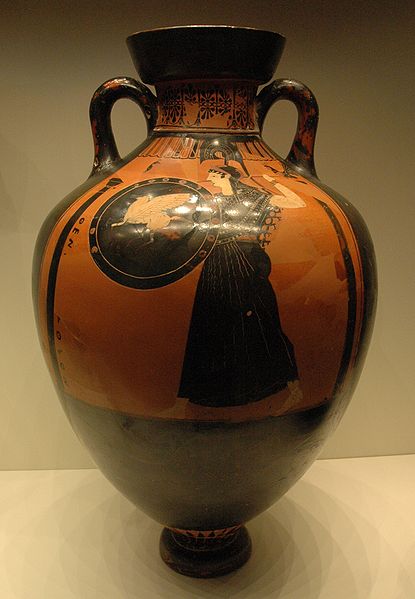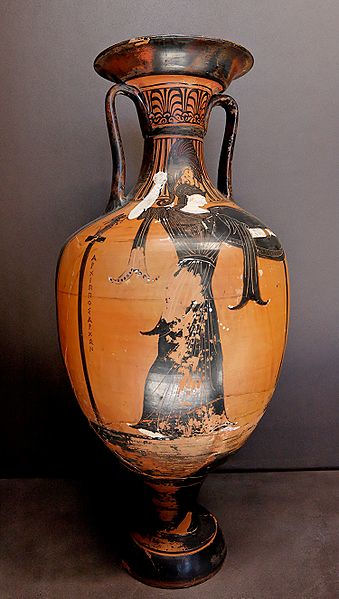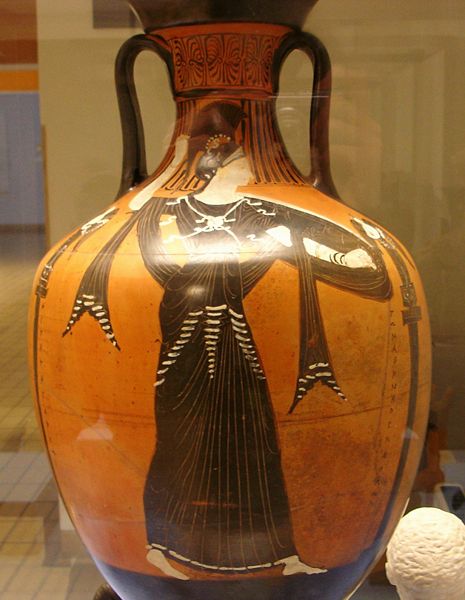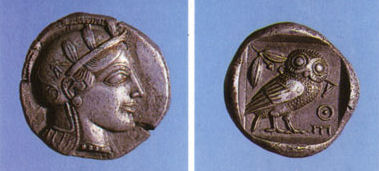The White Moon Goddess Gallery Presents
Athena in the Homeric Epics:
Rediscovering Her ComplexityLevel One Project by Literata
Initiate in the Sisters of the Rising Moon School© 2011. All original material in this site is under copyright protection and is the intellectual property of the author.
Bas-relief sculpture of the Roman goddess Minerva recovered from the ruins of Herculaneum
(Image in the public domain)
For the purpose of this project, I focused on Athena as she is represented in the Homeric epics and related tales. Although Athena’s worship began well before that time and has intriguing possible connections to prehistoric goddess worship, and also continued into the Roman period with multiple syncretizations, I wanted to reexamine the character of the goddess as captured in the older Greek myths. Greek and Roman mythology is commonly taught in schools, including allusions to it as an original source of Western culture, and the Homeric epics in particular are often held up as some of the earliest extant literature. The passing familiarity that results from this kind of exposure can give an impression that Athena is a warrior goddess, or a goddess of wisdom, although most people have trouble remembering exactly the role she played in the Iliad; the myth most commonly associated with Athena is the story of Arachne, which is one of the few where the goddess alone takes center stage.1 The story of Arachne emphasizes the goddess’ patronage of weaving as a useful household art, but the short vignette hardly captures the dynamic vitality of Athena’s character as she appears throughout the earlier epics. By comprehensively reviewing her appearances in the Homeric epics, this project strives to rediscover the complex nature of Athena in the Archaic period and to understand how that persona of the goddess might be approached in the context of contemporary women’s spirituality.
In the Homeric epics, Athena’s primary role is as a warrior: she is commonly referred to as “heaven’s triumphant maid,” “the martial maid,” or as the “all-conquering.” 2 Her other most frequent epithet is “blue-eyed maid,” which may also be translated as “shining-eyed” or “gleaming-eyed.” In Homer’s tales, references to her mastery or patronage of weaving are only side-lights. In a couple of instances, she appears in human form as “a fair virgin in her beauty’s bloom, / Skill’d in the illustrious labours of the loom,” and it is specifically mentioned that when Hera wanted to impress Zeus with her beauty, she wore a robe woven by Athena, but no specifics of this weaving are mentioned. The vast majority of Athena’s appearances refer to her wearing armor or being in disguise.
Ancient Coins with Images of Athena
( © Marie-Lan Nguyen / Wikimedia Commons)Her varied appearances are the first example of Athena’s complexity. She does not conform to simple ideas of gender for either the ancient Greeks or for us. Her role in the Iliad, in fact, is due in part to this masculine attitude: she was one of the three goddesses who claimed the golden Apple of Eris (Discord). Paris, judging between the three, refused Athena’s offered bribe of wisdom and skill in war. Instead, he judged in favor of Aphrodite, accepting from her the love of Helen, the most beautiful mortal woman. Aphrodite approached Paris using the wiles of beauty and the promise of love to win him over; Athena, and Hera, who also lost, approached him almost as an equal, trying to win him over with offers in the masculine realms of rulership and war. Afterwards, Hera and Athena had a solid alliance because of their loss, and Athena often acts on Hera’s behalf.
Interestingly, Athena also acts in Zeus’ name and even uses his symbols: the aegis was originally his, although it appears more often as part of Athena’s equipage; when she takes the form of a bird, it is as an eagle, Zeus’ bird, not an owl; and with his permission, she even wields the thunder and lightning that are Zeus’ identifying characteristics. Thus Athena’s outward signs and symbols are almost universally masculine. In fact, the way she crosses gender boundaries almost seems to deprive her of a gender of her own: she is not described as virgin solely because she had “autonomy and independence.” 3 She is virgin in the literal sense as well; no myth depicts her having a lover, human or immortal, or even to be interested in one.4
Her status as transgressing or simply disregarding gender boundaries does grant her unusual freedoms, though, and makes her the ideal intermediary between the goddesses and the gods. Athena’s work on Hera’s errands and her own often involves interacting with Ares or Apollo, or even Zeus. Ares, when fully engaged in his martial bloodlust, seems almost unapproachable, especially by one of the unarmored goddesses, but Athena faces him without fear. In contrast, although she is approached by other goddesses, Athena is only invoked by a woman in the Homeric epics on behalf of a man. Hecuba, queen of Troy, petitions Athena once, when advised to do so by her warrior son, and pleads for Athena’s mercy on the city, but Athena refuses to hear her. Later, Penelope petitions Athena to watch over Telemachus, the son of Athena’s favorite hero, Odysseus. This petition is successful, but Athena was already helping Telemachus, and did so for Odysseus’ sake, not because of Penelope’s petition. When Penelope bemoans her own situation or asks for help from a goddess, she turns to Artemis, not Athena.
Given these interactions, it is perhaps unsurprising that in her relationship with her devotee, Odysseus, Athena acts more as a comrade or advisor than as a mother. Even in combat and when protecting his life, Athena’s assistance is not described in the way other goddesses’ supervision of their charges is; she is much more likely to take form and engage in combat alongside Odysseus, or to act on his behalf, than to coddle or nurture him. When she does engage in combat, Athena’s approach to fighting is as complex as her gender presentation.
Amphorae with Images of Athena
(Left photo: Creative Commons Attribution-Share Alike 2.0 Generic license.)
(Center and right photos: Images in the public domain)
In one dramatic scene, she appears on the battlefield to face down her brother Ares, and after he insults her and implies she is merely causing trouble, she picks up a rock and knocks him unconscious with a single blow. In another violent scene, at the end of the Odyssey, she inflames an already tense situation and engineers a complete massacre. But almost immediately thereafter, she overrides Odysseus’ fury and enforces a peace on both sides once her sense of right and wrong has been satisfied. In contrast to Ares’ bloodlust in battle, she seems constantly focused on a purpose; victory in combat is only a means toward an end for Athena.
The greatest single example of her approach to combat is the Trojan horse, the epitome of cleverness and trickery. She inspires the craftsman with its design.5 After this stratagem succeeds, though, the triumphant Greeks fail to pay her sufficient homage, and in anger she wrecks several ships as they begin their journey home. This episode exemplifies how Athena’s pragmatic approach to combat applies her wisdom in order to satisfy her overriding ideas of justice.
Neither her wisdom nor her justice are at all what many contemporary readers might expect, especially from a goddess. Although she is often called the goddess of wisdom, Athena’s expertise might be better described as cunning. She appreciates trickery and does not shy from it herself, in matters as large as the Trojan horse and as small as appearing in the form of a mortal when addressing those who call on her. Athena disguises herself as a good friend of the person to whom she speaks, both to lead Hector to his death and to answer Penelope’s appeal. Odysseus himself is best known for his cunning and wit, not his abstract knowledge or impartial wisdom, and he frequently relies on Athena’s ability to change his outward appearance. Just as Athena spends most of her time carrying a masculine appearance and doing things that are unexpected of a goddess, she seems to value the same gift for inventiveness in her followers.
Athenian Tetradrachm
(Image in the public domain)
Her unique approach to morality is best summed up in a tale that is scattered in fragments throughout the Homeric epics. After Agamemnon, the leader of the Greeks, returned home, he was killed by his wife and the lover she has taken while he was gone. His son, Orestes, avenges his father by killing his mother and her lover. For the terrible act of killing his mother, Orestes is pursued by the Furies who seek vengeance, but he appeals to Athena. She establishes a law court on the Areopagitica to judge his case, and when the court’s vote is tied, she casts the final vote, finding Orestes not guilty. One telling gives her explanation as: “I was not borne by a mother. I, a virgin, sprang from the head of Zeus, my father, and I protect the rights of father and son against those of the mother. And so I shall not take the part of the woman who slew her husband to please her wicked lover.” 6
The overall image of Athena that emerges is composed of a mass of contradictions: she is a virgin who appears and acts in masculine ways, an extremely powerful warrior who disdains fighting for fighting’s sake, and a patroness of cunning who renders judgment based on her own sense of justice, being willing to face down the Furies and deny them vengeance in the process. She is, most of all, a figure of extreme practicality, willing to use appearances to get what she wants, but cutting through what she regards as irrelevant to pursue her own goals with single-minded focus.
Although the Homeric epics do not depict women calling on Athena for their own purposes, she is a figure to whom many women can appeal today, faced as they are with shifting gender boundaries and conflicting messages about appearance and behavior. A woman could call on Athena when she needs to borrow the goddess’ talent for disguise, when she has to cross boundaries and pursue her own goals, and most of all when she is unwilling to be bound by external strictures or expectations about her behavior as a woman.
The following ritual is designed to attract Athena’s attention for those purposes. The text is assembled out of adaptations of Pope’s verse translations of the Iliad and the Odyssey. It uses bread, wine, and olive oil, staples of Greek life. Wine is specified here because it was the normal drink of the day; if you need to substitute grape juice, that is appropriate too. Olive oil is sacred to Athena because she gave the gift of the olive tree in order to win a competition and become the patron of the city of Athens, which then named itself after her.7 Athena’s practicality carried the day again: in the Greek period, olive oil was a food and condiment, the primary substance for cleansing one’s skin, and more.
Ritual to Petition Athena
Cast a circle as usual; call the four quarters by inhaling the scents of bread, wine, and oil, then raising the offering of oil to the south (for the sun’s fire that ripened the olives), wine to the west, and bread to the north.
Do a self-blessing, using the olive oil to anoint yourself.
Recite:I sing Athena’s praise and know, you power above,
With ease can save each object of your love;
Wide as your will extends your boundless grace;
Not lost in time nor circumscribed by place.
The salted cakes upon the plate are laid,
And thus I here invoke Athena’s aid:
Daughter divine of Zeus, whose arm can wield
The avenging bolt, and shake the dreadful shield
I raise to you the bowl with rich red wine
Petitioning you to hear this plea of mine.
Your gift, the olive, here poured forth as oil
In my libation, asks your aid in toil.
Athena, ever on your charge attend,
And with your golden lamp my need befriend.
If you, the ever-wise, put forth your power,
Then prudence saves me in the needful hour.
The more shall Pallas aid my just desires,
And guard the wisdom which herself inspires.Dip the bread in the olive oil, then eat most of it, and drink most of the wine, leaving a small portion of each to give as an offering.
Turn to each direction, offering your thanks, then open the circle as you usually do. Take your offerings outside to give them back to the goddess.
